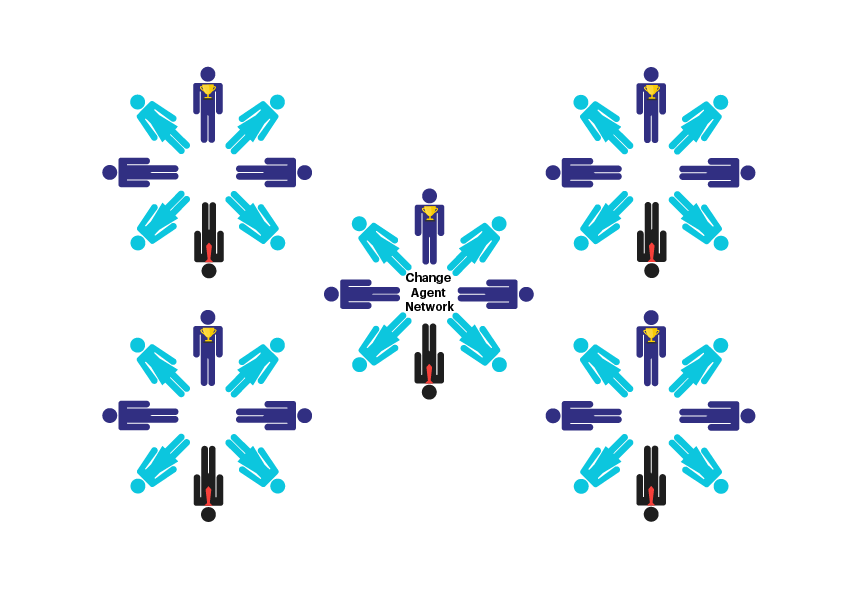Transforming a Public Sector Department: The Journey to Becoming Service-Oriented

Before I joined the public sector, I primarily had experience in private and parastatal organisations. Honestly, joining the public sector was a total culture shock. In terms of timelines, there was a sense that deadlines followed their own processes that were unclear to many, and the leadership style displayed a lot of command and control, which was dated. Furthermore, there seemed to be limited systems in place to deal with job-performance issues.
Regrettably, South Africa is less of a service-oriented country. It’s incredible to see how other cultures perform in the service sectors. Internationally, service is paramount because that brings people back to your business. Moreover, a sense of accountability in foreign public organisations appears to be lacking in their South African counterparts. While public sectors in South Africa deal with stakeholders, their interpretation of service can be quite different from those in the private sector leading to tension and dissatisfaction.
Background to the Culture Change
I was employed as an internal consultant by a provincial department to implement a transformational change program. Where many before me could not achieve, I was tasked with picking up the reigns and trying once more to turn the department into a service-oriented organisation and therefore deliver on its mandate. When I joined the department, I was shocked by the amount of apathy toward service and between employees and leadership. I had to establish why such a dangerous culture permeated the department. My investigations led me to the employee satisfaction surveys and others by my predecessors.
These surveys covered everything from corporate culture to diversity and climate. One key factor, however, was that with each subsequent round of surveys distributed, fewer and fewer employees were responding, with the latest batch getting feedback from less than 40% of the employees. From those few that had responded, It was clear that employees were unhappy about the current work environment. There was an underlying conflict between the organisations employees, leadership, and labour unions. All these critical stakeholders could not see eye to eye. Ultimately employees had disengaged because their feedback was never listened to and, therefore, not acted upon.
It was obvious to me that this much-needed change had stalled, despite being precisely what was needed. I picked up where my predecessor left off and set out to implement a culture change as a starting point to improve the working environment and ultimately achieve a more service-oriented department goal.
The Way Forward
From the diagnosis drawn from these previous surveys and engagements with employees, unions, and leadership, I was able to draw up a Change Management roadmap to ascertain focus areas and enable a greater impact to spearhead this transformational journey. A “building blocks” five-year change roadmap was ultimately drawn up. This vehicle would hopefully take us to where we wanted to be. One thing clear was that everyone across the organisation was eager to see a change.

With this hunger for change and understanding that this journey was needed and necessary, the organisation embarked on this journey on the premise that “a well-designed culture that aligns with the strategy and desired results is the bedrock of the most high-performance organizations in the world.”
A culture change is no simple task nor achieved overnight, and while I had anticipated a three-year journey, a fourth and fifth year would be needed to reinforce the new way of doing things and sustaining the culture. This was possible. As long as we had a vision and a common goal, we could achieve it. This change journey, amongst other interventions and programs, would have to involve organisational structure review, leadership development, culture renovation, employee engagement, Talent Management, 360° assessments, and intense building of change management capabilities at all levels across the organisation. These were the main areas of focus to get us to our goal. My secondary goals were to see the department becoming an employer of choice—an effective service provider in delivering on its mandate—and pride itself as a high-performing organisation.
Scope of the Change
The department is not massive, with roughly 500 employees, including contractors. The nature of the department’s operations is such that it engages, supports, and oversees the operations of all other departments in the province. We ensured that money was being spent as intended. At the same time, when these departments procure services, they should follow the right procedures. So much depends on the department’s effective operations and smooth service delivery. Hence, the essential delivery of this transformation change journey where this culture change was the basis of all.
Unfortunately, this is often not the only challenge in a government organisation. Rigid structures and bureaucracy govern public enterprises in South Africa, and if you want to innovate or enact change, it must be done in line with governing acts and prescripts. Do you see the paradoxical nature of this change? Unlike the private sector with free reign to enact change, the public sector is very political. There is always this balancing act at play. The trick was getting all involved to understand that the change is needed and that each one within the department must change at an individual level.
While the culture change was not the only change required within the department, it was the basis of all other changes. It influences the work environment, leadership, interpersonal relationships, physical environment, union relationships, and so much more that is needed to enact effective change. So much follows naturally from a culture change.

I looked at all previous surveys on culture, diversity, and climate. While they were already two or three years old, the information was still invaluable. The key failure had been a lack of follow-up actions. They promised much and delivered little. I decided to take a different approach, focusing on inclusion. The key was giving everyone a voice in how to achieve this culture change.

The second town hall sessions went far better because employees saw that action was being taken and, most importantly, an approach of inclusivity was adopted. Some of the previous tensions had dissipated.
Despite the impact of COVID-19, we were on track with our now four-year plan. We had stayed the course and delivered on promises. To navigate the pandemic’s uncharted waters and ensure that productivity was at acceptable levels, I designed a COVID-19 Resilience Survey. This helped the organisation self-assess and understand their “disruption readiness.” This also assisted in staying on the transformation course we had embarked on.
Now that we had affected some form of employee buy-in, a key challenge was how we would structure the culture change. Based on previous surveys, I identified five primary themes for the culture change:

- Dress code: I look professional, and I take my job seriously. My presentation to those around me represents how I feel about my job.
- Work quality and innovation: Quality talks to standards. We can only achieve a constant quality standard if we innovate as a service delivery organisation.
- Work Ethic: Collaboration, Communication, and Continuous feedback.
- Meetings and Events: Structure, punctuality, attendance, and sufficient preparation show that you are invested in your organisation. Professional conduct is paramount.
- Respect and professionalism: We must professionally conduct ourselves within the department and without. Mutual respect between leadership, employees, and unions must be nurtured. Basic manners often indicate one’s character and how people see us.
Seeing It Through
These factors were a good starting point, but now we needed to effect the behaviour and mindset change. To make it stick and get everyone to identify with the culture change, I came up with the concept of “The Department Way.” These principles defined who we were as an organisation, binding us together. They would be core to the way we operated. Furthermore, everyone was encouraged to contribute to these values. To ensure the culture change stuck, I devised a competition to see which of our colleagues were best at living “The Department Way” by subscribing to the new way of doing things. Colleagues could nominate one another if they were seen to be living and enacting one of the key themes mentioned above, and they had the potential to become the face of that theme. We also devised the role of “Ambassador for The Department Way,” an overall winner who embodied at least three or more of the five key themes of our organisational culture, as voted by their colleagues.
Of paramount importance was that these behaviours shouldn’t become a “one-and-done” event. Key sponsors were put in place to endorse and lead the change. At our bi-annual employee day, we had the sponsors speaking in support of the change, union representatives endorsing what they felt was a valuable change, and employees communicating their positive experiences of the change. These motivating factors helped instil a new culture within the organisation. The Ambassadors and faces of the values would also not be a one-off opportunity. We ensured that everyone had an opportunity to become an “Ambassador for The Department Way” each year and that the title, along with an incentive, could be awarded to anyone who meets the criterion.

Critically the Ambassador was not just a fancy title. This individual would have the authority to call out management when they failed to nurture our new values. They would be included in critical meetings regarding the culture changes, so they had first-hand information to communicate to their colleagues. They became our ULTIMATE change champion.

Overall the change was a resounding success. Everyone was excited to “live The Department Way,” and I recall some of my favourite snippets around the water cooler, like “you can really feel the change” and “the atmosphere here is different.” My personal favourite interaction was when an employee informed me that they “even read [my] emails and are looking forward to change.”
As change practitioners, it is our job to become the nagging voice to stay true to our role as leaders in a change. It’s not always comfortable, but it must be done. Importantly, the change is never over. We continue to drive Prosci Methodology in the workplace to build change capabilities. We have trained the sponsors, senior leadership, and middle management. Now we’re moving on to deliver training at the supervisory and employee levels. We are also running a home grown leadership development program over the next 13 months from the time of writing. This has offered an opportunity to engage leadership in robust discussions to take our change journey to the next level and ensure everyone speaks the same language: the language of change, facilitating the transformation.